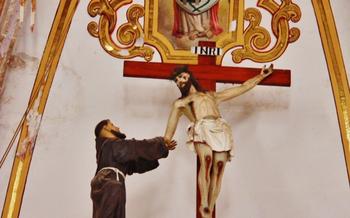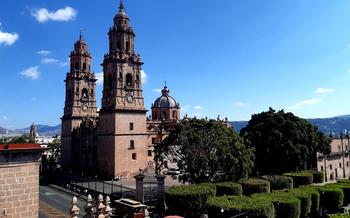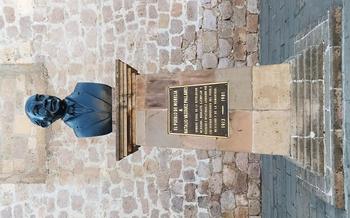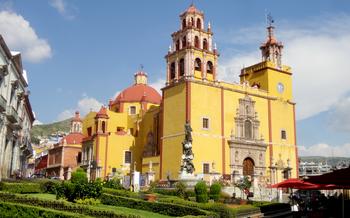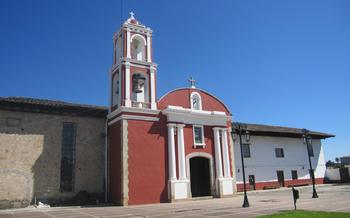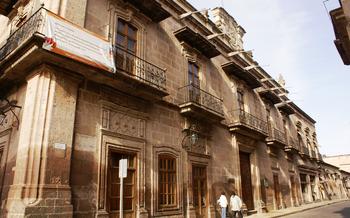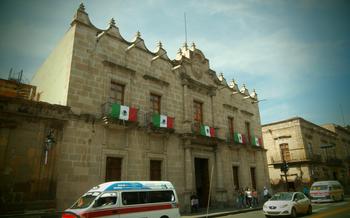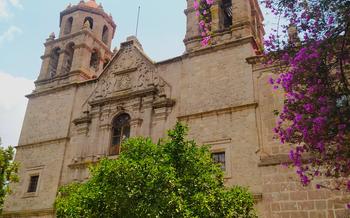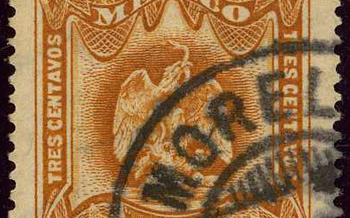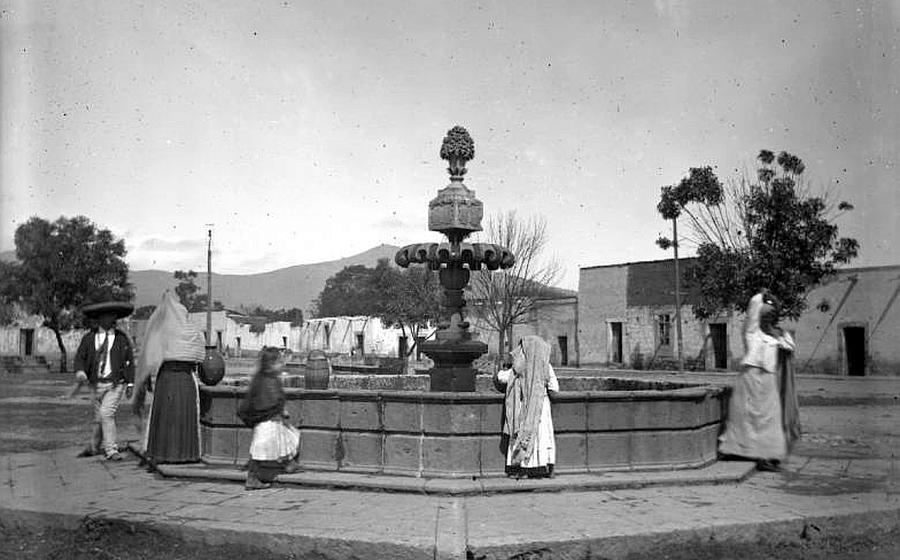
Calle Real de Pátzcuaro
- Must-See Buildings:
- Cultural Significance
- Street Vendors
- Shopping Opportunities
- Festivals and Events
- Architecture
- Museums:
- Art Galleries
- Accommodation
- Restaurants
- Transportation
Must-See Buildings:
Strolling along the enchanting Calle Real de Pátzcuaro, visitors are captivated by a remarkable array of architectural treasures that narrate the city's rich history. Among these edifices, four stand out as must-see landmarks that encapsulate Morelia's cultural essence:
-
The Templo de San Francisco: This magnificent 16th-century church, adorned with intricate Plateresque details, boasts a majestic facade that draws the eye. Its interior is adorned with stunning frescoes, gilded altars, and a resplendent rose window, creating an awe-inspiring ambiance.
-
The Colegio de San Nicolás: Founded in 1540, this venerable institution is considered the birthplace of the University of Michoacán, the oldest university in the Americas. Its grand facade showcases a harmonious blend of Renaissance and Baroque elements, while its elegant courtyard exudes tranquility.
-
The Casa de la Sirena: This charming 18th-century mansion, named for the mermaid adorning its facade, is a testament to the city's architectural heritage. Its intricate iron balconies, carved stone doorways, and colorful tilework evoke a bygone era of opulence.
-
The Palacio Clavijero: Once a Jesuit college, this splendid 17th-century edifice now houses the Museo Michoacano, which showcases a diverse collection of regional artifacts, pre-Hispanic sculptures, and colonial-era paintings, providing a glimpse into the state's rich cultural legacy.
Cultural Significance
Calle Real de Pátzcuaro is a street steeped in cultural significance, embodying the essence of Morelia's rich history and identity. It serves as a vibrant hub for art, music, and literature, showcasing the city's creative spirit. Throughout the street's storied past, it has played host to a captivating array of historical figures, leaving an indelible mark on its cultural landscape. From renowned artists and musicians to influential writers and intellectuals, the street has fostered a thriving community of creative minds.
Moreover, Calle Real de Pátzcuaro is deeply intertwined with local traditions and festivals, serving as a stage for the city's vibrant cultural expressions. During the annual Festival Internacional de Música de Morelia, the street transforms into a musical haven, resonating with the melodies of renowned performers. The street is also a focal point for the city's renowned Noche de Muertos (Day of the Dead) celebrations, where elaborate altars adorn the sidewalks, paying homage to departed loved ones. These festivals and traditions are an integral part of the city's cultural fabric, and Calle Real de Pátzcuaro provides the perfect backdrop for these vibrant displays of cultural heritage.
Street Vendors
Along the Calle Real de Pátzcuaro, one cannot miss the vibrant presence of street vendors. These enthusiastic entrepreneurs line the sidewalks, displaying a tantalizing array of traditional Mexican delicacies. From the sizzling aromas of freshly grilled corn on the cob to the sweet temptations of handmade churros, the street vendors offer a culinary adventure that is sure to delight every palate.
Each vendor has their own unique story to tell. Some have been in the trade for generations, passing down family recipes and traditions that have stood the test of time. Others are newcomers, bringing fresh ideas and flavors to the culinary landscape. Regardless of their background, they all share a passion for serving up delicious food and interacting with visitors.
The street vendors of Calle Real de Pátzcuaro play a vital role in the local economy. They provide employment opportunities for many people and contribute significantly to the city's vibrant street life. By supporting these vendors, visitors not only get to enjoy authentic Mexican cuisine but also contribute to the preservation of local traditions and the livelihoods of these hardworking individuals.
When interacting with street vendors, it is important to be respectful and mindful of their time. Be prepared to pay in cash, as most vendors do not accept credit cards. It is also customary to bargain, but always do so in a friendly and respectful manner. By embracing the local culture and engaging with the vendors, visitors can create a truly memorable and rewarding experience for themselves and contribute to the vibrant tapestry of life on Calle Real de Pátzcuaro.
Shopping Opportunities
Calle Real de Pátzcuaro is a shopper's paradise, with a wide range of shops and boutiques to cater to every taste and budget. From traditional Mexican crafts and souvenirs to high-end fashion and jewelry, visitors can find everything they need and more along this vibrant street.
One of the most popular items to buy on Calle Real de Pátzcuaro are the beautiful hand-crafted goods made by local artisans. Visitors can find everything from colorful pottery and textiles to intricate silver jewelry and wood carvings. These one-of-a-kind items are perfect for souvenirs or gifts, and they help support the local economy.
In addition to traditional Mexican crafts, Calle Real de Pátzcuaro is also home to a number of unique shops and boutiques that sell everything from vintage clothing to contemporary art. Visitors can find unique items that they won't find anywhere else, and they can support local businesses at the same time.
Bargaining is expected when shopping on Calle Real de Pátzcuaro, so don't be afraid to haggle with the vendors to get the best price. However, it's important to be respectful and to remember that the vendors are making a living.
With its wide variety of shops and boutiques, Calle Real de Pátzcuaro is the perfect place to find unique souvenirs, gifts, and one-of-a-kind items. Visitors can support local artisans and businesses while finding the perfect item to take home from their trip to Morelia.
Festivals and Events
The Calle Real de Pátzcuaro is a vibrant and lively street, especially during festivals and events. One of the most famous is the Festival of San Francisco, held every October. The festival honors the patron saint of the city, and features colorful processions, traditional dances, and live music. Another popular event is the International Cervantino Festival, which showcases a variety of artistic performances, including theater, music, and dance. During the Day of the Dead, the street is decorated with colorful altars and offerings, and locals celebrate with traditional food, music, and costumes. These festivals and events are a great way to experience Mexican culture firsthand and to learn about the city's history and traditions.
Tips for attending the festivals and events:
- Plan ahead and book your accommodation in advance, as the city gets very crowded during major festivals.
- Wear comfortable shoes, as you'll be doing a lot of walking.
- Bring a camera to capture the colorful sights and sounds of the festivals.
- Be prepared for crowds and noise, especially during the most popular events.
- Respect local customs and traditions, and be mindful of your behavior.
Architecture
Calle Real de Pátzcuaro is a living museum of architectural styles. From the colonial baroque of the Templo de San Francisco to the neoclassical Palacio Clavijero, the street showcases the evolution of Mexican architecture over centuries. Each building has its own unique story to tell, reflecting the city's rich history and cultural heritage.
Admire the intricate facade of the Templo de San Francisco, with its elaborate carvings and statues. Step inside to see the beautiful altarpieces and paintings that adorn the interior. The Colegio de San Nicolás, founded in 1540, is one of the oldest educational institutions in the Americas. Its elegant Renaissance-style architecture reflects its long and prestigious history.
Don't miss the Casa de la Sirena, a charming 18th-century mansion named after the mermaid statue that adorns its facade. The Palacio Clavijero, built in the 19th century, is a stunning example of neoclassical architecture. Its grand columns and ornate balconies make it one of the most photographed buildings in Morelia.
As you stroll along Calle Real de Pátzcuaro, take the time to appreciate the unique architectural details that make each building special. From the wrought-iron balconies to the colorful tiles, every corner of the street reveals a new treasure.
Museums:
Along the Calle Real de Pátzcuaro, visitors can find several museums that offer a glimpse into the city's rich history and culture. The Museo Regional de Michoacán is the largest and most comprehensive museum in the city, showcasing a vast collection of artifacts and exhibits that tell the story of Michoacán's indigenous cultures, colonial past, and modern-day traditions. The Museo de Arte Contemporáneo Alfredo Zalce is dedicated to contemporary Mexican art, featuring works by renowned artists such as Alfredo Zalce, Diego Rivera, and Frida Kahlo. For those interested in learning about the city's colonial history, the Museo Casa Natal de Morelos is a must-visit. This museum is housed in the birthplace of José María Morelos, a hero of the Mexican War of Independence. It features exhibits on Morelos' life and contributions to the independence movement.
Tips for visiting the museums:
- Plan your visit: Check the museum's website or call ahead to find out about hours of operation, admission fees, and any special exhibitions or events.
- Take your time: Don't rush through the museums. Take your time to read the exhibits, admire the artwork, and soak in the atmosphere.
- Ask questions: If you have any questions, don't hesitate to ask a museum staff member. They are there to help you make the most of your visit.
- Take advantage of guided tours: Many museums offer guided tours, which can be a great way to learn more about the exhibits and the museum's history.
- Support the museums: Consider making a donation to the museums you visit. Your support helps to ensure that these important cultural institutions can continue to operate and provide educational and cultural experiences for visitors.
Art Galleries
Calle Real de Pátzcuaro is home to a variety of art galleries, each showcasing unique works from talented local artists. The galleries feature a diverse array of artistic styles and mediums, including paintings, sculptures, pottery, and textiles. Visitors can admire the vibrant colors and intricate details as they stroll through the galleries, and perhaps even purchase a special piece to take home.
One of the most popular galleries on the street is the Galería de Arte Contemporáneo, which showcases works from both established and emerging contemporary artists. The gallery is known for its cutting-edge exhibitions and its role in promoting new artistic talent. Another must-visit gallery is the Galería de Arte Indígena, which specializes in traditional Mexican art and crafts. The gallery features a stunning collection of handmade pottery, textiles, and jewelry, all created by indigenous artisans from various regions of Mexico.
Accommodation
Calle Real de Pátzcuaro offers a variety of accommodation options to suit every budget and preference. From budget-friendly hostels and guesthouses to luxurious hotels, there's something for everyone.
For a truly unique experience, consider staying in one of the many historical mansions that have been converted into charming bed and breakfasts. These mansions offer a glimpse into the city's past and often feature beautiful courtyards, gardens, and rooftop terraces.
If you're looking for a more modern option, there are several boutique hotels located along the street. These hotels offer stylish accommodations, often with a contemporary design and amenities such as rooftop pools and fitness centers.
No matter what your budget or preferences, you're sure to find the perfect place to stay on Calle Real de Pátzcuaro.
Here are some tips for finding the best accommodation:
- Book your accommodation in advance, especially if you're traveling during the peak season.
- Consider your budget and what amenities are important to you.
- Read reviews of different accommodations online to get a sense of what other travelers have experienced.
- If you're staying in a historical mansion, be sure to ask about the history of the building.
Insider Tip: For a truly unique experience, try staying at the Hotel Casa de la Sirena. This beautiful hotel is housed in a 17th-century mansion and features a stunning courtyard, a rooftop terrace, and a swimming pool.
Restaurants
Calle Real de Pátzcuaro is a culinary paradise, offering a diverse selection of restaurants that cater to every taste and budget. From traditional Mexican cuisine to international fare, there's something for everyone to enjoy.
For those seeking an authentic Mexican experience, there are numerous restaurants serving up classic dishes such as enchiladas, tacos, and tamales. These restaurants often have a warm and inviting atmosphere, with colorful décor and friendly staff.
If you're in the mood for something different, there are also several international restaurants to choose from. These restaurants offer a variety of cuisines, including Italian, French, Japanese, and Chinese. Many of these restaurants have outdoor seating, allowing diners to enjoy their meals al fresco while taking in the sights and sounds of the street.
No matter what your budget, you're sure to find a restaurant to your liking on Calle Real de Pátzcuaro. There are several affordable options, including street stalls and casual cafes, as well as more upscale restaurants for those looking for a special dining experience.
To make the most of your dining experience, be sure to try some of the local specialties, such as carnitas, pozole, and uchepos. And don't forget to save room for dessert, as there are several excellent bakeries and ice cream shops along the street.
Transportation
Calle Real de Pátzcuaro is easily accessible by various means of transportation. Buses are the most common and affordable option, with multiple routes running along the street. Alternatively, taxis are readily available and offer a convenient way to get around. For those seeking a more immersive experience, walking is a fantastic way to explore the street, allowing you to soak up the atmosphere and admire the intricate details of the architecture.
If you're arriving by car, several parking lots are located within walking distance of the street. However, keep in mind that parking can be limited, especially during peak tourist seasons. Once parked, you can seamlessly transition into discovering the wonders of Calle Real de Pátzcuaro.
